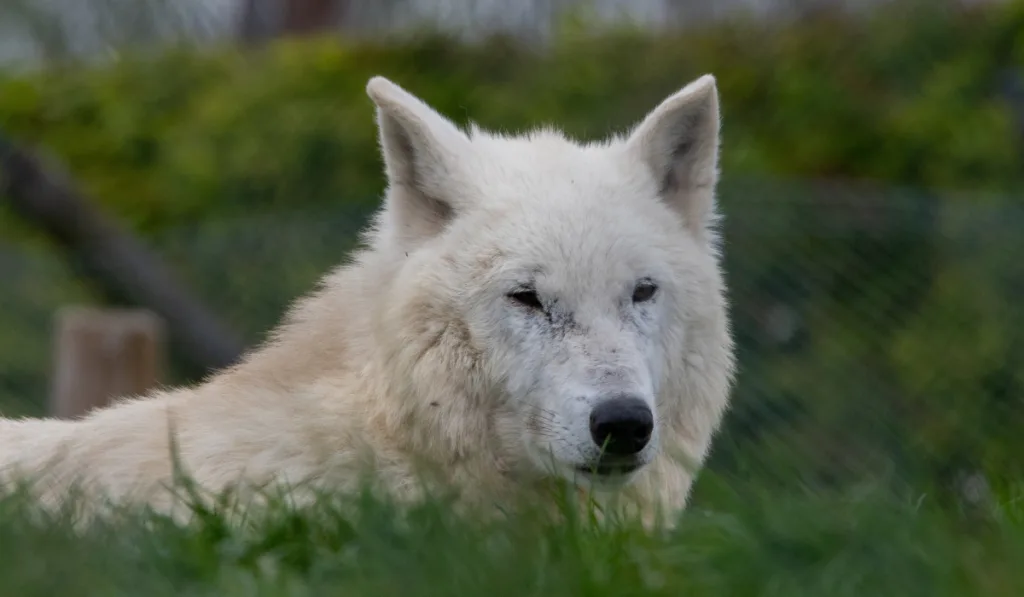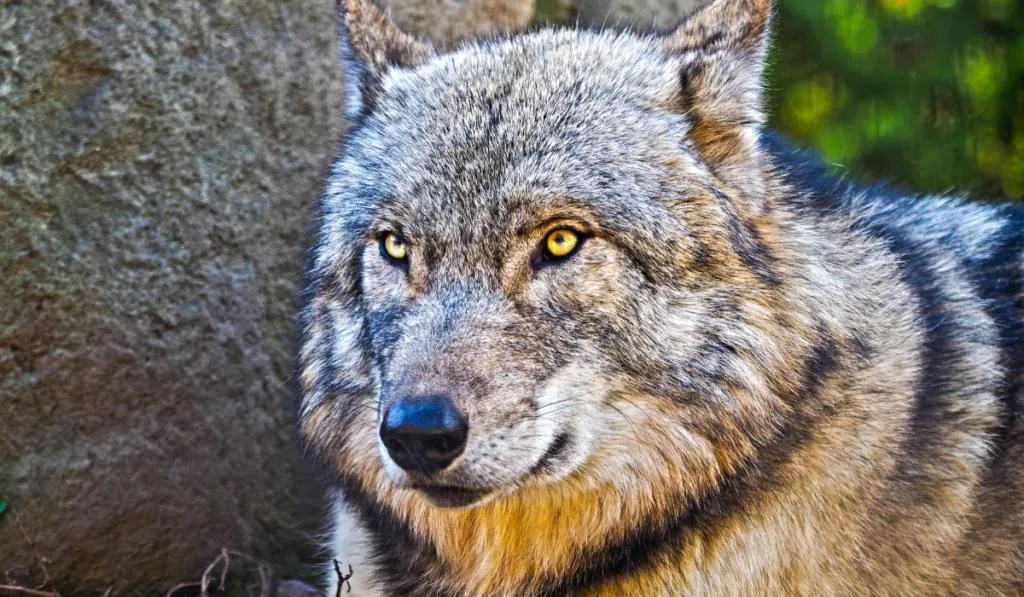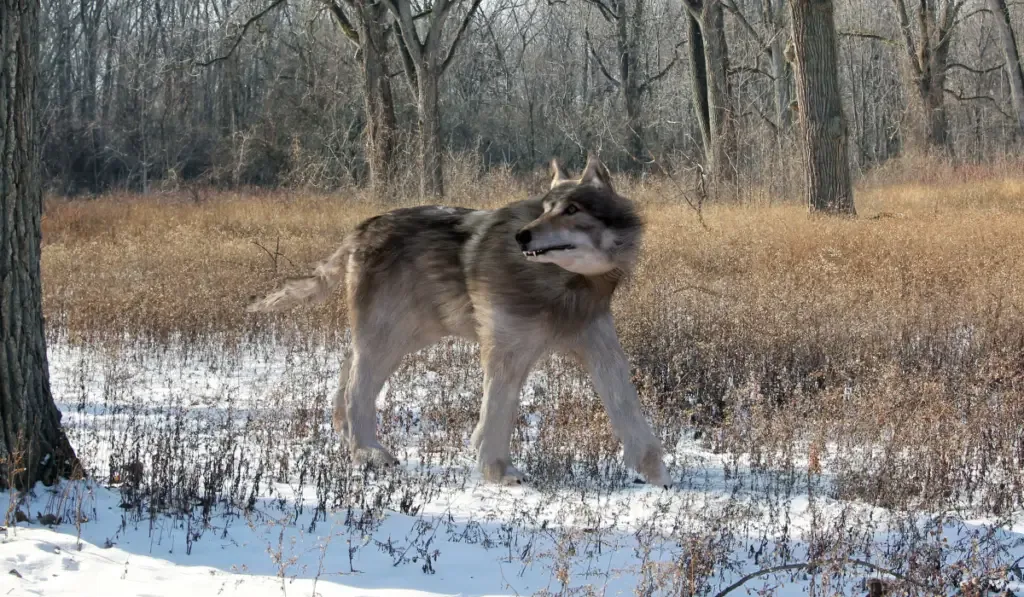Wolves are the largest members of the canine family. There are debates over how many species are in existence. However, it is widely accepted that there are currently 2 wolf species: grey wolves (lupus) and red wolves (rufus).
Beyond the 2 species, there are many subspecies of grey wolves around the world, particularly North America. They vary in size, appearance, and ease of sighting.
In this article, we will review both extant and extinct species of wolves and sampling of their subspecies.
Table of Contents
Arctic Wolf

As the name hints, the Arctic wolf lives in arctic regions around Greenland and North America. The Arctic wolf is a subspecies of grey wolf, and it is also called Polar wolf or White wolf.
Many types of wolves are at risk of being hunted by humans. However, the Arctic wolf is not. They are the only type of wolf free currently free of human threat. Arctic wolves typically do not come across humans and are not endangered by hunters.
Arctic Wolves weigh between 70-175 pounds. They grow as long as 3.2-5.9 feet and typically inhabit tundra climates.
Like all wolves, Arctic wolves are carnivorous and essential to the balance of the ecosystem. They feed on animals such as caribous, bison, carrion, hares, musk ox, lemmings, and even livestock.
Arctic wolves move in packs that cover significant territories. They typically cover around 1000 square miles, and the pack size depends on the available food.
Arctic wolves are adapted to survive the temperature extremes of their habitat. They have furry paws, thick body fur, small ears, and a thick layer of fat.
Manitoba Wolf
The Manitoba wolf was a grey wolf that is now extinct. It had made its home throughout various parts of Canada including Manitoba (as evident in the name), Saskatchewan, Alberta, and Northwest Territories.
The Manitoba wolf was also called the Grey-White wolf. It was revered for its fur, and it was hunted for this purpose. However, it sadly went extinct in the early part of the 20th century due to uncontrolled hunting.
Hudson Bay Wolf

The Hudson Bay wolf is another grey wolf. They originally roamed the northwestern Hudson Bay Coast in Canada and northern Keewatin. They now live primarily in northern Manitoba, western Hudson Bay, and the Northwest Territories.
The Hudson Bay wolf is medium sized and described as having white fur and a relatively flat skull. It is a carnivore that typically feeds on bison, beavers, reindeer, white-tailed deer, and moose.
Adult Hudson Bay wolves grow as tall as 2.3-3 feet with bodies as long as 4-5 feet. The males are usually slightly larger than the females. On average, they weigh 80-140 pounds.
Japanese Wolf
The Japanese wolf, also called the Honshu wolf, is believed to have gone extinct, but there have been local sightings of this subspecies.

Around 1905, an epidemic hit the Japanese wolves, and a large number of them died leading to their extinction.
This subspecies of Grey Wolves was revered in Japan. In some religions, it was associated with hallowed entities. While they existed, Japanese Wolves roamed 3 of Japan’s islands: Honshu, Shikoku, and Kyushu.
The Japanese wolf is one of 2 types of wolves that used to live in Japan. The other was the Hokkaido wolf, which was also a grey wolf. The Hokkaido wolf is also believed to be extinct.
The Japanese wolf was one of the smallest wolves at the time it existed. But its actual adult size is not known for sure.
Alexander Archipelago Wolf
Alexander Archipelago wolf is one of the smaller wolf species. It is a grey wolf that originates in the Alexander Archipelago islands and roams areas of the southeastern Alaskan mainland.
This type of wolves fancies habitats with dense and undeveloped forests. They prefer those with abundant sources of food and sufficient old growth.
On average, Alexander Archipelago wolves grow as long as 3.5 feet and as tall as 2 feet. They typically weigh 30-50 pounds and have a relatively dense black or grey coat.
These wolves become sexually mature within 2-3 years of their lives. They mostly feed on Sitka black-tailed deer. They also feed on beavers, moose, and mountain goats.
It is estimated that the population of the Alexander Archipelago wolf stands at about 50-89. The main threats to the existence of these canines is hunting and loss of habitat. These animals are currently considered endangered.
Eastern Wolf

Some consider the Eastern wolf to be a subspecies of the Grey wolf. However, recent genomic studies have backed the claims that the Eastern Wolf might be a species on its own.
The Eastern wolf is also known as Algonquin wolf, Eastern Canadian Red wolf, or Eastern Canadian wolf. It is thought to be the result of a mix between grey wolves and coyotes or red wolves.
Eastern wolves are not built like the typical Grey wolf. Eastern Wolves take on a more coyote-like appearance.
While their back and some of their sides are covered with black hair, their pelt is not. The pelt of an Eastern wolf is greyish-brown while the fur behind their ears is red.
Members of this group of wolves are mostly found in the Algonquin Provincial Park in Ontario, Canada. They may also be found in certain parts of Quebec, Manitoba, and Minnesota, USA.
The Eastern wolf originally roamed freely in the United States, but Europeans settlers pushed them out. It is estimated that there are only less than 500 left in the wild.
Eastern wolves feed on rabbits, moose, white-tailed deer, and various rodents.
Arabian Wolf
Arabian wolves are grey wolves typically found in the Arabian Peninsula.
You’ll find them in areas around Oman, Jordan, Yemen, and Saudi Arabia. They are also seen in western and southern Iraq and the Egyptian Sinai Peninsula.
On average, members of this subspecies reach heights around 2.2 feet, and they grow to weigh as much as 40 pounds. The Arabian wolf is the smallest wolf subspecies still in existence.
Unlike some other grey wolves, Arabian wolves are adapted to the desert heat and not to cold environments. They have relatively large ears for easier heat dissipation. They also have short and relatively sparse fur.
One unique feature of the Arabian wolf is the fusion of their 2 middle toes. Another peculiar trait in them is that they do not howl.
They typically move in small groups: Arabian wolves usually move in pairs or packs of 3-4, but a group of 12 has been sighted.
Arabian wolves usually feed on small animals and medium-sized animals. They will eat any type of domestic animal that is as large as a goat. Arabian wolves will eat hares, goats, cats, and carrions. They also eat sweet fruits sometimes.
Red Wolf

The Red wolf is midway between a grey wolf and coyote in size. It is considered to be the second species of wolf beside the grey wolf.
The Red Wolf is the most endangered wolf in the world. Currently, there are only around 35 wild Red wolves in the world.
They are found in eastern North Carolina, particularly the Alligator River National Wildlife Refuge. Around 245 members of this species remain captive in 43 breeding facilities across the US.
The Red wolf is indigenous to the Southern and the Eastern United States. While it used to roam these areas in the past, its prevalence has reduced drastically. Loss of habit and predator control programs of the early 20th century contributed massively to the drop in population.
Red wolves grow as tall as 2.2 feet and weigh 45-80 pounds. They are typically 4 feet long and are markedly larger than coyotes.
As their name hints, Red wolves are brown or buff with some black on their blacks. Their muzzles are broad, heads wide, ears pointy, and legs slender.
This species of wolf typically move in packs of 5-8 members. Each pack usually has a breeding pair. Red wolf breeding pairs remain together for life and mate only in February.
Red wolves are opportunistic feeders. Sometimes they travel as far as 20 miles in search of food. They will feed on animals such as white-tailed deer, rabbits, raccoons, and other small mammals. This species can feed on as much as 2-5 pounds of food per day.
Dire Wolf
If you’ve watched Game of Thrones, then you have heard of Dire wolves. Dire wolves are real wolves, but they are now extinct. They lived about 252,000 years ago during the Pleistocene epoch.

If Dire wolves were still in existence, they would have been another species all to themselves besides red and grey wolves.
Dire Wolves are the largest wolf species ever to exist. They were about 25% larger than the grey wolves of today.
Fossils of Dire wolves have been found across North America through both Canada and the USA. They have also been found in the northern parts of South America. Dire wolves were reported to have roamed from Canada to Bolivia. They also lived in China.
On average, Dire wolves reached heights of 2.6-2.8 feet and lengths of 5 feet. They weighed around 110-174 pounds and could eat prey twice their size.
One other peculiar fact about the Dire wolves is the force of their bite. They could bite more than 2 times harder than grey wolves.
Wolf Species Overview
The following table gives a comparison overview of the different wolf types discussed throughout this article.
| Type of Wolf | Species | Location | Average Adult Height/Length | Average Adult Weight |
| Manitoba Wolf (Extinct) | Grey Wolf (lupus) | Manitoba, Saskatchewan, Alberta, and Northwest Territories | – | – |
| Hudson Bay Wolf | Grey Wolf (lupus) | Northern Manitoba, Western Hudson Bay, and the Northwest Territories | 2.3-3 feet tall | 80-140 pounds |
| Arctic Wolf | Grey Wolf (lupus) | Arctic regions around Greenland and North America | 3.2-5.9 feet long | 70-175 pounds |
| Japanese Wolf (Extinct) | Grey Wolf (lupus) | Honshu, Shikoku, and Kyushu – Japan | – | – |
| Alexander Archipelago Wolf | Grey Wolf (lupus) | Alexander Archipelago islands and Southeastern Alaskan Mainland | 2 feet tall | 30-50 pounds |
| Eastern Wolf | Grey Wolf (lupus) | Algonquin Provincial Park in Ontario, Quebec, Manitoba, and Minnesota, USA. | 2.7 feet tall | 66 pounds |
| Arabian Wolf | Grey Wolf (lupus) | Arabian Peninsula and Sinai Peninsula including parts of Oman, Jordan, Yemen, Saudi Arabia, Iraq | 2.2 feet tall | 40 pounds |
| Dire Wolf (Extinct) | Dire Wolf (dirus) | – | 2.6-2.8 feet tall | 110-174 pounds |
| Red Wolf | Red Wolf (rufus) | Alligator River National Wildlife Refuge in North Carolina. | 2.2 feet tall | 45-80 pounds |
Other Types of Wolves
- Steppe wolf
- Alaskan Tundra wolf
- Newfoundland wolf (extinct)
- Vancouver Island wolf
- Labrador wolf
- Mexican wolf
- Northwestern wolf
- British Columbia wolf
Resources
- https://wolf.org/wolf-info/basic-wolf-info/types-of-wolves/
- https://news.google.com/newspapers?id=Y-QdAAAAIBAJ&sjid=o0kEAAAAIBAJ&pg=3095,2664277&dq=manitoba-wolf&hl=en
- https://archive.org/stream/proceedingsofbi541941biol#page/112/mode/2up
- http://www.google.com/books?id=JgAMbNSt8ikC&pg=PA575%E2%80%93577
- https://thewolfintelligencer.com/hudson-bay-wolf-canis-lupus-hudsonicus/
- https://wolveswolveswolves.fandom.com/wiki/Hudson_Bay_wolves#
- https://www.worldwildlife.org/species/arctic-wolf
- https://www.coolantarctica.com/Antarctica%20fact%20file/wildlife/Arctic_animals/arctic_wolf.php
- https://wwf.panda.org/our_work/our_focus/wildlife_practice/profiles/mammals/arcticwolf/
- https://wolfology1.tripod.com/id147.htm
- https://www.jstor.org/stable/1178791
- https://books.google.com/books?id=NBUTCgAAQBAJ
- https://pubmed.ncbi.nlm.nih.gov/19877836
- https://www.biologicaldiversity.org/species/mammals/Alexander_Archipelago_wolf/natural_history.html
- https://animalcorner.org/animals/eastern-wolf/
- https://nywolf.org/learn/eastern-wolf/
- https://www.inaturalist.org/taxa/636555-Canis-lupus-arabs
- https://animals.fandom.com/wiki/Arabian_Wolf
- https://www.nationalgeographic.com/animals/mammals/r/red-wolf/
- https://www.fws.gov/southeast/wildlife/mammals/red-wolf/
- https://doi.org/10.1016%2Fj.quaint.2020.09.054
- https://www.mentalfloss.com/article/63309/10-fierce-facts-about-dire-wolves
- https://igws.indiana.edu/FossilsAndTime/DireWolf
- https://www.nps.gov/whsa/learn/upload/Dire_Wolf_09_23_16_-335KB_PDF.pdf https://www.earthrangers.com/eastern-wolf
